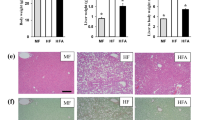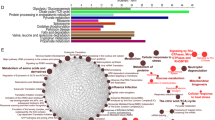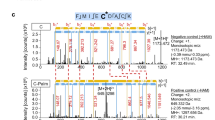Abstract
Aim:
Free fatty acid-induced lipotoxicity plays a crucial role in the progression of nonalcoholic fatty liver disease (NAFLD). In the present study we investigated the effects of a high-fat diet and free fatty acids on the autophagic process in hepatocytes in vivo and in vitro and the underlying mechanisms.
Methods:
LC3-II expression, a hallmark of autophagic flux, was detected in liver specimens from patients with non-alcoholic steatohepatitis (NASH) as well as in the livers of C57BL/6 mice fed a high-fat diet (HFD) up to 16 weeks. LC3-II expression was also analyzed in human SMMC-7721 and HepG2 hepatoma cells exposed to palmitic acid (PA), a saturated fatty acid. PA-induced apoptosis was detected by Annexin V staining and specific cleavage of PARP in the presence and absence of different agents.
Results:
LC3-II expression was markedly increased in human NASH and in liver tissues of HFD-fed mice. Treatment of SMMC-7721 cells with PA increased LC3-II expression in time- and dose-dependent manners, whereas the unsaturated fatty acid oleic acid had no effect. Inhibition of autophagy with 3MA sensitized SMMC-7721 cells to PA-induced apoptosis, whereas activation of autophagy by rapamycin attenuated PA-induced PARP cleavage. The autophagy-associated proteins Beclin1 and Atg5 were essential for PA-induced autophagy in SMMC-7721 cells. Moreover, pretreatment with SP600125, an inhibitor of JNK, effectively abrogated PA-mediated autophagy and apoptosis. Specific knockdown of JNK2, but not JNK1, in SMMC-7721 cells significantly suppressed PA-induced autophagy and enhanced its pro-apoptotic activity; whereas specific knockdown of JNK1 had the converse effect. Similar results were obtained when HepG2 cells were tested.
Conclusion:
JNK1 promotes PA-induced lipoapoptosis, whereas JNK2 activates pro-survival autophagy and inhibits PA lipotoxicity. Our results suggest that modulation of autophagy may have therapeutic benefits in the treatment of lipid-related metabolic diseases.
Similar content being viewed by others
Log in or create a free account to read this content
Gain free access to this article, as well as selected content from this journal and more on nature.com
or
References
Chitturi S, Wong VW, Farrell G . Nonalcoholic fatty liver in Asia: Firmly entrenched and rapidly gaining ground. J Gastroenterol Hepatol 2011; 26: 163–72.
Bugianesi E, Moscatiello S, Ciaravella MF, Marchesini G . Insulin resistance in nonalcoholic fatty liver disease. Curr Pharm Des 2010; 16: 1941–51.
Neuschwander-Tetri BA . Hepatic lipotoxicity and the pathogenesis of nonalcoholic steatohepatitis: the central role of nontriglyceride fatty acid metabolites. Hepatology 2010; 52: 774–88.
Hunter JE, Zhang J, Kris-Etherton PM . Cardiovascular disease risk of dietary stearic acid compared with trans, other saturated, and unsaturated fatty acids: a systematic review. Am J Clin Nutr 2010; 91: 46–63.
Karantza-Wadsworth V, White E . Role of autophagy in breast cancer. Autophagy 2007; 3: 610–3.
Mizushima N, Levine B, Cuervo AM, Klionsky DJ . Autophagy fights disease through cellular self-digestion. Nature 2008; 451: 1069–75.
He C, Klionsky DJ . Regulation mechanisms and signaling pathways of autophagy. Annu Rev Genet 2009; 43: 67–93.
Singh R, Xiang Y, Wang Y, Baikati K, Cuervo AM, Luu YK, et al. Autophagy regulates adipose mass and differentiation in mice. J Clin Invest 2009; 119: 3329–39.
Ding WX, Li M, Chen X, Ni HM, Lin CW, Gao W, et al. Autophagy reduces acute ethanol-induced hepatotoxicity and steatosis in mice. Gastroenterology 2010; 139: 1740–52.
Ebato C, Uchida T, Arakawa M, Komatsu M, Ueno T, Komiya K, et al. Autophagy is important in islet homeostasis and compensatory increase of beta cell mass in response to high-fat diet. Cell Metab 2008; 8: 325–32.
Mei S, Ni HM, Manley S, Bockus A, Kassel KM, Luyendyk JP, et al. Differential roles of unsaturated and saturated fatty acids on autophagy and apoptosis in hepatocytes. J Pharmacol Exp Ther 2011; 339: 487–98.
Tan SH, Shui G, Zhou J, Li JJ, Bay BH, Wenk MR, et al. Induction of autophagy by palmitic acid via protein kinase C-mediated signaling pathway independent of mTOR (mammalian target of rapamycin). J Biol Chem 2012; 287: 14364–76.
Choi SE, Lee SM, Lee YJ, Li LJ, Lee SJ, Lee JH, et al. Protective role of autophagy in palmitate-induced INS-1 beta-cell death. Endocrinology 2009; 150: 126–34.
Koga H, Kaushik S, Cuervo AM . Altered lipid content inhibits autophagic vesicular fusion. FASEB J 2010; 24: 3052–65.
Nehra V, Angulo P, Buchman AL, Lindor KD . Nutritional and metabolic considerations in the etiology of nonalcoholic steatohepatitis. Dig Dis Sci 2001; 46: 2347–52.
Malhi H, Bronk SF, Werneburg NW, Gores GJ . Free fatty acids induce JNK-dependent hepatocyte lipoapoptosis. J Biol Chem 2006; 281: 12093–101.
Pyo JO, Nah J, Jung YK . Molecules and their functions in autophagy. Exp Mol Med 2012; 44: 73–80.
Szumiel I . Autophagy, reactive oxygen species and the fate of mammalian cells. Free Radic Res 2011; 45: 253–65.
Czaja MJ . JNK regulation of hepatic manifestations of the metabolic syndrome. Trends Endocrinol Metab 2010; 21: 707–13.
Wong CH, Iskandar KB, Yadav SK, Hirpara JL, Loh T, Pervaiz S . Simultaneous induction of non-canonical autophagy and apoptosis in cancer cells by ROS-dependent ERK and JNK activation. PLoS One 2010; 5: e9996.
Acknowledgements
We thank Prof Mu-jun ZHAO for providing the GFP-LC3 plasmid. We are grateful to Dong-ping HU, Dan CAO, Dan-dan HUANG and Kun WU for their technical assistance. And we also thank Shanghai Dida Biotechnology Co, Ltd for technical assistance and data analysis. This research was supported by the projects from the Key Program of National Natural Science Foundation of China (90713032 and 81272212).
Author information
Authors and Affiliations
Corresponding authors
Additional information
Supplementary Figures are available in the website of Acta Pharmacologica Sinica.
Supplementary information
Supplementary Figure S1
Autophagy is enhanced in HFD mouse Liver and PA, but Not OA, induces autophagy in vitro. (JPG 2011 kb)
Supplementary Figure S2
PA induces autophagy in vitro. (JPG 1836 kb)
Supplementary Figure S3
Autophagy attenuates PA-induced apoptosis. (JPG 3471 kb)
Supplementary Figure S4
Inhibition of JNK activation reduces PA-induced autophagy. (JPG 1455 kb)
Rights and permissions
About this article
Cite this article
Tu, Qq., Zheng, Ry., Li, J. et al. Palmitic acid induces autophagy in hepatocytes via JNK2 activation. Acta Pharmacol Sin 35, 504–512 (2014). https://doi.org/10.1038/aps.2013.170
Received:
Accepted:
Published:
Issue date:
DOI: https://doi.org/10.1038/aps.2013.170
Keywords
This article is cited by
-
Signaling and other functions of lipids in autophagy: a review
Lipids in Health and Disease (2020)
-
In vivo and in vitro studies using Clonorchis sinensis adult-derived total protein (CsTP) on cellular function and inflammatory effect in mouse and cell model
Parasitology Research (2020)
-
The autophagic degradation of Cav-1 contributes to PA-induced apoptosis and inflammation of astrocytes
Cell Death & Disease (2018)
-
Autophagy Protects against Palmitic Acid-Induced Apoptosis in Podocytes in vitro
Scientific Reports (2017)
-
Crosstalk of 5′-Monophosphate-Activated Protein Kinase (AMPK) with Extracellular and Intracellular Signaling Pathways in the Regulation of Nutrient Metabolism and Cell Survival in the Liver
Current Pharmacology Reports (2017)



